Samsung SSD 870 EVO, 500 GB, Form Factor 2.5&rdquo

Samsung SSD 870 EVO, 500 GB, Form Factor 2.5”, Intelligent Turbo Write, Magician 6 Software, Black
Excellence in performance
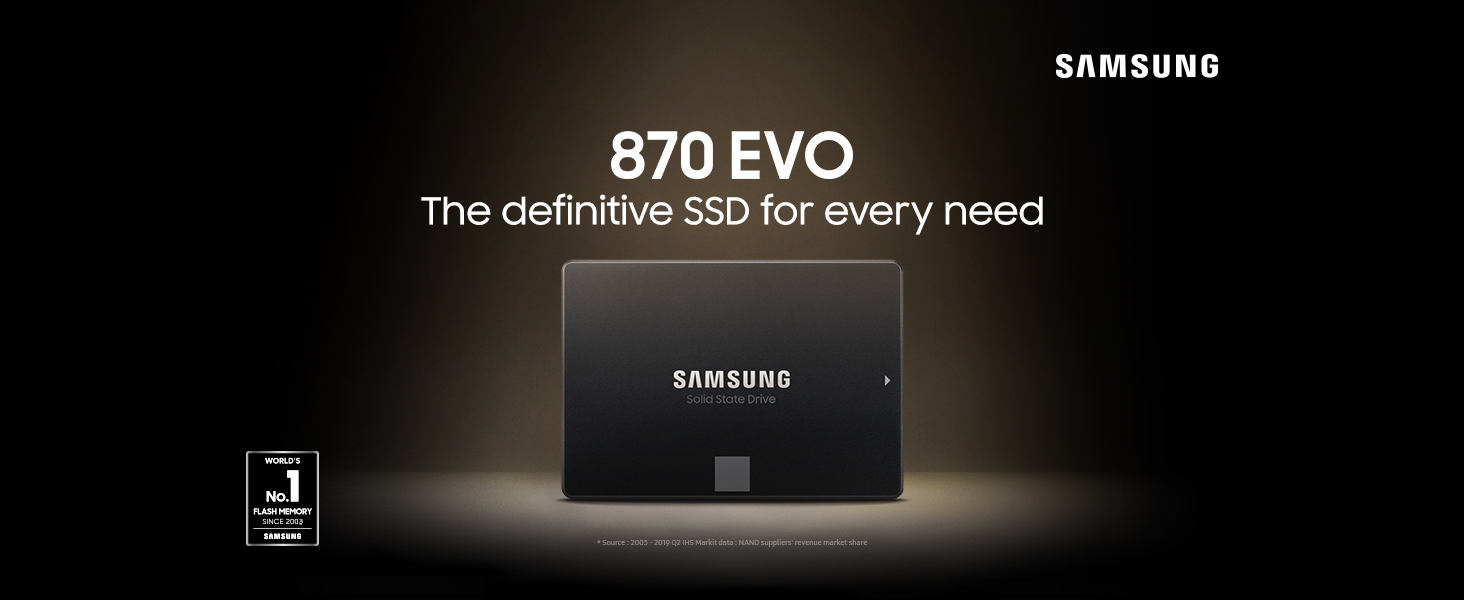
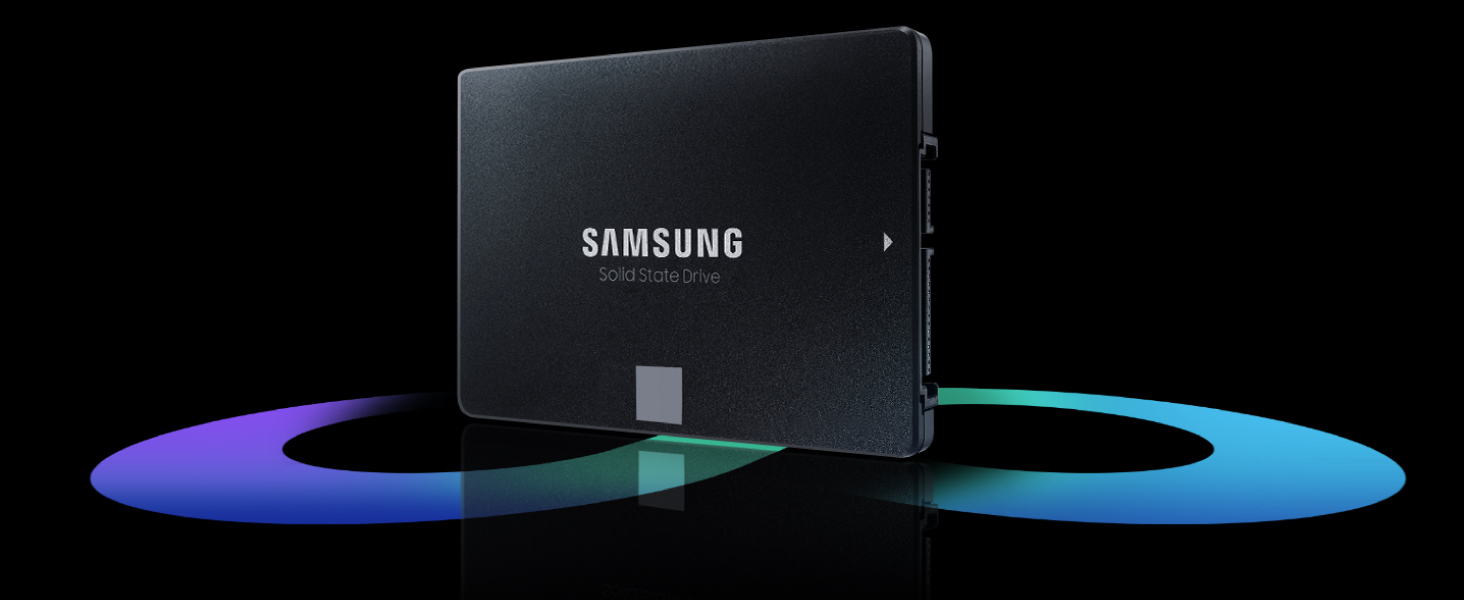
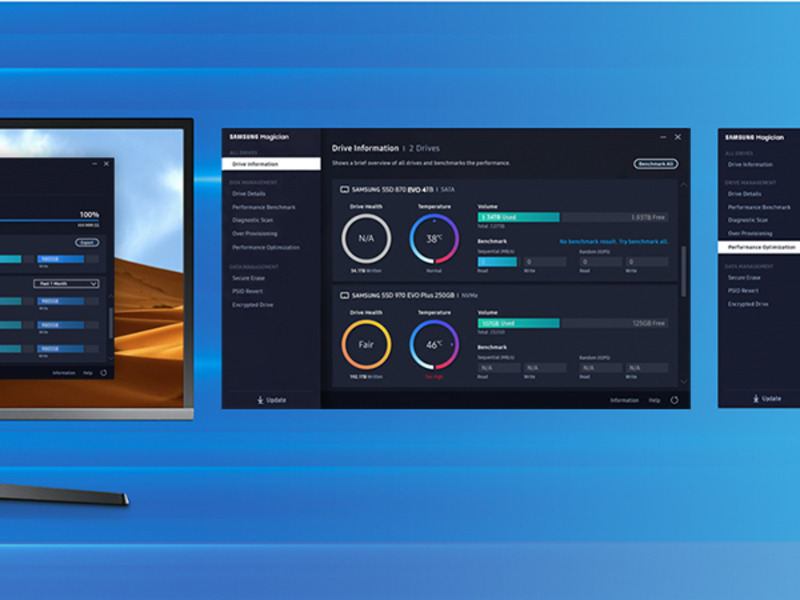
Comparison
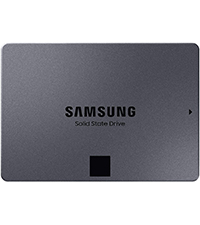 SATA SSD 870 QVO 2.5″ | 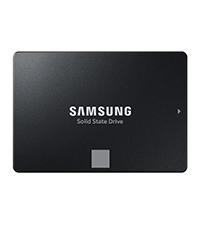 SATA SSD 870 EVO 2.5″ | 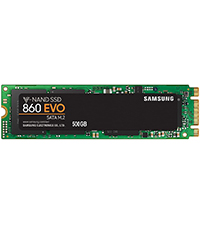 SATA SSD 860 EVO M.2 |  SATA SSD 860 PRO 2.5″ | 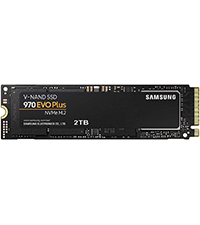 NVMe SSD 970 EVO Plus M.2 | |
| Reading Speed | 560 MB/s | 560 MB/s | 550 MB/s | 560 MB/s | 3500 MB/s |
| Writing Speed | 530 MB/s | 530 MB/s | 520 MB/s | 530 MB/s | 3300 MB/s |
| Capacity | 8TB; 4TB; 2TB; 1TB | 4TB; 2TB; 1TB; 500GB; 250GB | 1TB; 500GB; 250GB | 2TB; 1TB; 512GB; 256GB | 2TB; 1TB; 500GB; 250GB |
| TBW | 360 TBW | 600 TBW | 600 TBW | 1.200 TBW | 600 TBW |
| Flash Storage Technology | QLC | TLC | TLC | MLC | TLC |
| Application | Everyday use | Everyday use | Everyday use | Professional workstations | Gaming, photo / video editing |
¹ Performance may vary based on SSD’s firmware version and system hardware & configuration. Sequential write performance measurements are based on Intelligent TurboWrite technology.
² system configuration: Intel Core i7-7700K CPU @ 4.20GHz, DDR4 1200MHz 32GB, OS – Windows 10 Pro x64, Chipset: ASUS PRIME Z270-A. All performance data was measured with the SSD as a secondary.
³ TBW for 870 EVO: 150 TBW for 250 GB model, 300 TBW for 500 GB model, 600 TBW for 1 TB model, 1,200 TBW for 2 TB model and 2,400 TBW for 4 TB model.
| Weight: | 45.3 g |
| Dimensions: | 10 x 6.99 x 0.68 cm; 45.36 Grams |
| Brand: | Samsung |
| Model: | MZ-77E500B/EU |
| Colour: | Model specific |
| Batteries Included: | No |
| Manufacture: | Samsung |
| Dimensions: | 10 x 6.99 x 0.68 cm; 45.36 Grams |
as described fast delivery, speeded up a slow laggy laptop on windows 10,dropped a star because the Samsung ssd did not match the holes of the Samsung caddy in my np300v5a laptop so had to improvise
As I am a keen photographer, I wanted this drive to act as a separate “Share” for my QNAP NAS Drive, storing all out family photos on it and then using the QNAP app Qumagie to catalogue them.
Samsung EVO SSDs are dearer because they use MLC/TLC memory/flash, this stores less data per cell but the cells last a lot longer, so this should last many years.
I have 4 other of these at various capacities and an 860 EVO SATA SSD that is still going strong.
You can buy cheaper drives, but you cant buy better.
10/10
Installed it in a very old laptop (2010). Obviously since the laptop is SATA II, it will not benefit from the higher read/write speeds but needed some extra capacity. The SSD sent was quite old stock with a manufacturing date of April 2023. Had to reinstall the Magician software as at first, the various functions of the software were not available for the new drive. All working fine at the moment. Replaced a 3 year old 250GB 860 EVO which has been brilliant.
Wow what a transformation, swopped out my HDD with Samsung 1tb EVO, used Samsung magic drive software to transfer data between the drives, took 7 hours to complete 495gb transfer(Laptop uses USB2.0). Swopped out the drives and can’t believe the new performance transformation.
My laptop is an 8 year old Toshiba Satellite Pro and it’s now faster than when it was brand new. Highly recommend this SSD.
I purchased this Samsung SSD internal hard drive to replace a very old style HDD on a Packard Bell iMedia S2780 PC. Very easy to install by detaching the internal DVD drive and using its Sata/Power connections to connect the Samsung SSD. Downloading the free version Disk Genius utility and select ‘System Migration’ under the tools options I cloned the System Drive straight to the SSD which took 1.5 hours. Removing the DVD drive and old HDD, rebooted the PC and all done.
The Samsung Magician software only recognises and works with Samsung SSD disks so won’r be an option to migrate a non-samsung disk to a samsung SSD. Don’t waste your time with it.
It’s made a huge difference, and is something I really shouldn’t have delayed for so long.
I went with Samsung as they’ve rarely let me down with tech, and the price here was great.
I thought it was time to replace my old hard drive, so it went with the name everybody knows great little hard drive installed in under 10 minutes transferred windows 11with ease back up and running in half an hour, very happy with item.
Bought to replace hard drive. Computer now working about a hundred times faster, which is great. For anyone with EHS, be warned: the EMFs from the SSD, which I thought would be an improvement, have been quite hard to live with. None the less, I wouldn’t swap back, because the improved performance has been so welcome.
Samsung drives come with Samsung’s Magician migration software and this makes it straightforward to clone the old drive so it can be replaced with the new one. No issues with the old drive being the boot drive, run Magician, select clone, then replace the old mechanical disk with the new Samsung SSD. Easy!
This disk gets over 400MB/s for sequential read and write, compared to 60MB/s with the old hard drive (NB the age of the machine means it cannot saturate the 870 EVO which can reach >500MB/s for sequential read and write on a modern system). For random I/O, the number of operations per second is up from ~100 IOPS to over 50k IOPs, which is another world of performance and why the old laptop is now usable.
I’ve been buying SSDs for many years, but I’ve always filled them very quickly, as they’ve always been relatively expensive on cost per MB compared to a normal HDD. Even the 1TB one I purchased last year was full within 6 months, so I decided to bite the bullet and grab this 4TB version while the Black Friday sale was on, and I’m glad I did. It’s great to see all that free space! (Oh, did I mention it’s fast?)
Samsung know how to make a good SSD. This purchase was an upgrade from an 850 EVO which was still working absolutely perfectly, just needed more capacity. I bought the 2TB version this time not because I need all that storage but to future proof my PC since these are some of the most reliable drives money can buy.
Also the data transfer from the old drive to new was flawless with samsung’s magician software. Very seamless apple-like experience. Love these.
Samsung SSD 870 EVO are reliable, as they can withstand sudden power loss (when using a journalling filesystem), and have the best TBW (terabytes written) value among the top tier of similar products. The performance is enough to saturate the fastest SATA bus. It is likely to be about 10x faster than the old drive you are replacing, and about 3x-6x slower than a NVMe drive on PCIe bus. Basically, if the old computer can’t boot up from an NVMe, then this product is the best. As usual, always get a drive slightly larger than you need, because the reliability is proportional to the capacity in these devices (about 600TBW per 1TB).
I used these drives in my own pc so when it come to replacing one in a friends laptop it was a no brainer. Replacing his old HDD with this SDD, he won’t stop telling me how fast his laptop is now, even though it’s several years old
Bought to replace a scavenged drive from an old system I was updating for a friend, perfect little SSD to boot the OS from in a couple of seconds. Third one I’ve had for various set ups and always very reliable for the price
I had a 500gb ssd which was full. I attached this new disk internally and the magician software could not use it, it could see it but it would not let me select it as the target for cloning. I removed it and attached it via an external usb adapter and the cloning worked fine. It did take 5 hours to complete but it was 100% successful.
What can I say… download the software, press a couple of buttons and it’s cloned. No reason/excuse not to.
Again as it’s Samsung you hope for their quality but as it’s in a second desktop pc it won’t be used too often.
Very happy and actually first drive from them I have normally used other well known brand and was swayed just due to it being on offer.
Happy though with any as they all do pretty much the same unless you spend lots of money and want to check onboard controllers etc.
For Jane/Joe public this is ideal.
The drive was easy to install after watching a couple of quick YouTube videos, but I would be aware that you may need a longer connecting cable depending on the positioning of your components inside your tower. However, these are dirty and Natalie bailable too much about it if you do need one.
Arrived next day . You need a USB to SATA lead .
With the Samsung APP transfer of old hard disc was easy and so was installing it . It has significantly improved the speed of my laptop.
Initial shipped product was faulty. Disk could be seen BIOS and windows but unable to partition the disk to be usable, replaced extremely quickly at no charge. Otherwise a good SSD choice!
I have used Samsung SSDs for years without a problem. Only one (from 10) has shifted its bad storage elements (similar to bad-blocks on a hard disk). Done without problem, unobserved by me when it was done. The SSD was running windows7 on it at the time. Still going!
My pc was running really slow and noisy so my nephew suggested replacing hard drive. Apparently, though a bit concerned he assured me it was simple and would simply transfer all my data.
He was spot on when he said these Samsung drives are brilliant and easy to install.
I got this to be the boot drive for a new rig as I wanted the M.2 drive I purchased to be just for games. Sure it’s faster than a mechanical HDD and it’s slower than an M.2 drive, but with just Windows and a few other programs on its speed is of little concern to me. This SATA drive is of a known, reputable brand and if you need a drive then get one.
Down loaded Samsung Magician, plug in usb to sata cable and cloned old drive 1st time, with the 2nd drive just fitted it and formatted as usual. great value and quality you’d expect from Samsung.
Had this drive a while and it’s fine.
I’ve never got round, or felt inclined, to test it’s speed or capacity. But i’m happy with it.
Seemed like a decent price when i bought – now they seem to be giving them away.
Happy bunny
If you want it ro be fastest you could buy two and used it as a software Raid, Then you get double the speed,
But why when you could just buy a 4tb PCIE3.0 m.2 that’s 6x the speed for the same price for a different manufacturer?
Because simply old laptops/ Pc’s and last generation consoles don’t have an M.2 slot so you can’t use them and sata is the only option,
On the drive itself the 4tb 870 evo is excellent for a sata drive, It has dram inside 4gb infact, That’s like 2008 levels of ram in a top end pc of that time,
Why 4* rather than 5* you might ask?,
Actually plugging the drive in my pc only to run disk manager to format it and well… it could only format it to 2tb rather that 4tb but the remaining 2tb that was an not yet allocated couldn’t be merged into the volume,
The only solution I had was to remove the 870 evo plug in my sata to usb 3.1 cable I’ve had laying about for the past year and formatting as an external drive,
That worked then once that was done I then put it back in my pc to format once again,
I know I said at the start of this review that it’s just a sata drive,
But for most people that’s all you would ever need,
I have a 4tb firecuda 530 PCIE4.0 as my boot drive and this 4tb 870 evo is no where near the speed of that, But in games it’s identical for load times,
With certain games that are out in 2023 with the Direct storage api and now with NVIDIA RTX IO that will be out with rachet & clank rift apart on pc very soon ssd storage will be used to it’s full potential, Much like the near instant load times on the Playstation 5,
With direct storage and rtx io what’s the difference between 1 second with a PCIE4.0 ssd compared to 1.4 seconds to a sata ssd for game load times?,
You can’t even blink your eyes at 0.3 seconds,
Anyway for a summary,
Positive
+ 5 years of warranty
+ It doesn’t use QLC memory cells unlike the 870qvo
+78 GB cache size so you get full transfer speeds ( Most 4k video files are less than that)
Negative
= it’s a sata drive so if you do alot of 4k video editing at 60fps or 120fps then a PCIE4.0 would be better as the faster the drive you have the better really,
– My only personal issue of a brand new 4tb 870 evo not being able to format to the full capacity of the drive unless I used a cable to use it as an external drive to format it, If I didn’t already have that cable in my draw it would of been a problem,
Final summary,
I personal use this 4tb 870 evo as a steam game storage and pc games pass storage,
Why? Because some mad drivers in my area who like to crash into virgin media fiber cabinets and I’m left with no Internet for 10+ days and I don’t want to use my precious mobile data for game downloads because mobile data companies hate it when you use youe phone as a hotspot because apparently 600gb of 4/5g data is now somehow unlimited, And well we all know games are big now like 100gb + some are even 200gb,
If you can pick up a 4tb ssd for a decent price it’s worth it,
I wouldn’t worry at all about games that use direct storage in the future because the difference between PCIE4 or 5 or even Sata ssd will be less that a 2 seconds because the graphics card in your PC will be doing the decompression of the data
I would certainly suggest this as a suitable upgrade for anyone looking to reinvigorate an old tired PC where you’re just not ready to start all over again.
TLC NAND like from Samsung’s EVO series doesn’t slow down to below HDD speeds when moving lots of files like QLC NAND that you usually see at this price point, and it also has a much higher long term reliability due being able to be written on more and suffering from potential small charge errors less. This made this easily the best value drive on the market for me as I wanted to put in an external enclosure, format to ExFAT and use for media/games storage across multiple devices/locations, a situation where more expensive NVME would be nearly useless.
Came across a video last night and started panicking however the date shown is the exact same as the one you’d get if you purchased directly from the manufacturer.
If the SSD was manufactured after 11/2021 you should be perfectly fine, obviously like with everything in life there’s no guarantees.
Like i said i’ve had no issues whatsoever.
Hope this helps.
Never had a failure in my possession and I’ve been purchasing since the 830 and when they were 250 for a 256GB – almost a pound per GB. I still have an 830 drive right now, it’s in use on a fairly modern laptop. This modern laptop has had an 850 Evo, 860 Evo and 870 Evo, but now has the 830 as it’s not my main laptop anymore, just a tertiary one. I struggled to notice any real world difference between any of these SSDs. I’m sure there are differences but they’ll be fractions of seconds – not seconds.
Reliability is the king though and as I’ve bought 100’s of these models over the years (100’s of every Evo/general model Samsung have released) to use in various client and customer laptops, not one is yet to fail as far as I know.
Samsung’s selling point is that it’s all made under one roof – all of the silicon components – CPU, DRAM, the storage silicon, everything. As you may know, most other brands use different branded components within their SSDs. Not that I’ve seen any big issues over the last 5 or 6 years with other brands – everything is pretty ironclad these days with controllers, firmware, etc etc. But with Samsung there’s no guess games or testing – you know it’ll be solid right off the bat and their endurance rating will be credible. Harder to estimate this when using components from different manufacturers. For that reason alone I’ve always just stuck to Samsung for my SSD needs, whether the SATA models or the NVMe models.
The Magician software simplifies firmware management, the clone tool is great if needed (most I.T. technicians will be recovering images via other means anyway).
I feel they’ve always been competitively priced – I know other brands do price more aggressively but in the grand scheme of things, I feel that data shouldn’t have a price (or not too large a price). The Samsung drives are still competitively priced with that in mind. And I do feel that with real-world workflows, the superiority of the Samsung drives can be felt at times over other budget brands – especially under random loads and I think Samsung’s great processor design comes into play here. Other brands have always been playing catch-up with this – Samsung have always headlined.
Recommended for use in anything you need storage in this form factor – external USB chassis (they’re GREAT for external drives – they’ll beat off even the best USB flash drives once they’re in a quality USB 3.0 chassis), game consoles, computers and laptops, iMacs & MacBooks (SATA only), NAS drives for either storage or caching. I honestly believe that unless for mass storage, the hard disk drive has no place anymore.
– Lasts **27 days** if you run UserBenchmark testing 24/7.
– Lasts 35.4 years if you run Win10 OS drive with a swap file 24/7.
– Lasts 53.2 years if you run Win10 OS drive without a swap file 24/7.
– Lasts 100+ years in real life conditions working on a computer 9-16 hours a day and power cycling once or twice a day.
**results calculated without taking into account the 10% over-provisioning I’m using, so actual lifespan will be higher
Detailed summary
My 9 year old Samsung 830 SSD, used solely as operating system drive, was running out of space. Windows Search’s database (a lifesaver for me) was approaching 60GB in size pushing my small 128GB SSD near its capacity limits. The 830’s performance was still rock solid and its health was at 80% after 9 years of almost daily use. So decided to purchase this 1TB Samsung Evo 870.
Cloning
I used Samsung’s disk cloning tool to migrate the operating system. This caused me some stress. I noticed not all files were copied. Specifically: my Outlook PST files and Windows’ search database were missing. I worried system files might also have failed to clone so undertook a set of windows checks using SFC and DISM. They all came out clean. Turns out, if you use Samsung’s software, you need to ensure all programs are closed (my Outlook was – but a tray icon was still running probably locking the PST files) and if you want Windows Search databases copied, you must temporarily disable Windows Search. Wish this had been clearer upfront which would have avoided my rebuilding the Search database.
Then came the SSD writes shock
After checking the drive for issues with Samsung Magician, cloning the OS, and completing a tests with UserBenchmark, I was shocked to discover that in 15 Power on Hours (PoH) I had already eaten through 306 GB of SSD writes! The drive was new with 0 GB writes, how could this be possible? At this rate, it was going to last 3.4 years with 24/7 use.
I thought something was wrong with the drive so began recording SSD writes vs. PoH and testing different scenarios.
First, I moved Windows’ swap file to a 12TB HGST helium drive. This instantly ‘fixed’ the SSD writes and I incorrectly concluded Windows was chewing up my drive. Spent a few days reading up about the problem and trying to figure out solutions.
I then decided to test my PC again with UserBenchmark to see what impact having a swap file on a separate HDD was having. I could not believe it: one test burnt off 30GB in SSD writes!! So the culprit was not Windows but the five or six UserBenchmark tests I had completed after cloning the drive.
I placed the swap file back onto my C: drive and sure enough SSD writes were not increasing at alarming rates. I also read that Windows will not let HDDs with a swapfile spin down and sleep, so another reason to leave the swap file on the SSD.
Thanks to all the data points I recorded, I can now estimate that this drive will last 35.4 years powered on continuously, or 102.8 years at the rate that I am using my computer.
So a highly recommend from me.